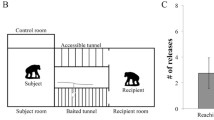Abstract
Evolutionary psychologists have highlighted the importance of trust in human social relations. The impact of an incident of food theft on impressions of both “victims” and perpetrators was investigated using videos of six mixed-sex pairs of adult actors eating in a restaurant. These were viewed by 191 adults who then provided their impressions including ratings of the actors on Trustworthiness and Sneakiness scales. Seeing a single incident of theft of a small portion of another’s food was sufficient to alter impressions of the perpetrators’ trustworthiness and sneakiness, as well as hiring decisions and judgements of relationship fidelity and self-confidence. Being a victim of food theft had no effect on these but did lower ratings of the male victims’ confidence. The results demonstrate the power of a minor social transgression to alter impressions of trustworthiness and other traits.
Similar content being viewed by others
References
Alley, T. R. (2010). An observational study of sharing ‘contaminated’ foods in mixed-sex dyads as an indicator of intimacy and attraction. Presented at the 20th biennial congress of the International Society for Human Ethology. Madison, WI: University of Wisconsin.
Azrin, N. H., & Wesolowski, M. D. (1974). Theft reversal: an overcorrection procedure for eliminating stealing by retarded persons. Journal of Applied Behavior Analysis, 7(4), 577–581.
Bell, R., & Buchner, A. (2012). How adaptive is memory for cheaters? Current Directions in Psychological Science, 21(6), 403–408.
Bieneck, S., & Krahé, B. (2011). Blaming the victim and exonerating the perpetrator in cases of rape and robbery: is there a double standard? Journal of Interpersonal Violence, 26(9), 1785–1797.
Blurton Jones, N. B. (1984). A selfish origin for human food sharing: tolerated theft. Ethology and Sociobiology, 5(1), 1–3.
Boon, S. D., & McLeod, B. A. (2001). Deception in romantic relationships: subjective estimates of success at deceiving and attitudes toward deception. Journal of Social and Personal Relationships, 18(4), 463–476.
Bowles, S., & Gintis, H. (2004). The evolution of strong reciprocity: cooperation in heterogeneous populations. Theoretical Population Biology, 65(1), 17–28.
Buchner, A., Bell, R., Mehl, B., & Musch, J. (2009). No enhanced recognition memory, but better source memory for faces of cheaters. Evolution and Human Behavior, 30(3), 212–224.
Colquitt, J. A., Scott, B. A., & LePine, J. A. (2007). Trust, trustworthiness, and trust propensity: a meta-analytic test of their unique relationships with risk taking and job performance. Journal of Applied Psychology, 92(4), 909–927.
Cosmides, L. T., & Tooby, J. J. (1992). Cognitive adaptations for social exchange. In H. Barkow, L. Cosmides, & J. Tooby (Eds.), The adapted mind: evolutionary psychology and the generation of culture (pp. 163–228). New York: Oxford University Press.
Cottrell, C. A., Neuberg, S. L., & Li, N. P. (2007). What do people desire in others? A sociofunctional perspective on the importance of different valued characteristics. Journal of Personality and Social Psychology, 92(2), 208–231.
DeSteno, D., Breazeal, C., Frank, R. H., Pizarro, D., Baumann, J., Dickens, L., & Lee, J. J. (2012). Detecting the trustworthiness of novel partners in economic exchange. Psychological Science, 23(12), 1549–1556. doi:10.1177/0956797612448793.
Efferson, C., & Vogt, S. (2013). Viewing men’s faces does not lead to accurate predictions of trustworthiness. Scientific Reports, 3(1047). doi:10.1038/srep01047.
Engell, A. D., Haxby, J. V., & Todorov, A. (2007). Implicit trustworthiness decisions: automatic coding of face properties in the human amygdala. Journal of Cognitive Neuroscience, 19(9), 1508–1519.
Gollwitzer, M., Rothmund, T., Alt, B., & Jekel, M. (2012). Victim sensitivity and the accuracy of social judgments. Personality and Social Psychology Bulletin, 38(8), 975–984.
Ha, R. R., & Ha, J. C. (2003). Effects of ecology and prey characteristics on the use of alternative social foraging tactics in crows, Corvus caurinus. Animal Behaviour, 66(2), 309–316.
Harrell, W. A., & Goltz, J. W. (1980). Effect of victim’s need and previous accusation of theft upon bystander’s reaction to theft. Journal of Social Psychology, 112(1), 41–49.
Kaplan, H., & Gurven, M. (2005). The natural history of human food sharing and cooperation: a review and a new multi-individual approach to the negotiation of norms. In H. Gintis, S. Bowles, R. Boyd, & E. Fehr (Eds.), Moral sentiments and material interests: the foundations of cooperation in economic life (pp. 75–113). Cambridge, MA: MIT Press.
Krüger, B., Baumann, J., Abdallah, M., & Weber, A. (2011). A study on perceptual similarity of human motions. In J. Bender, K. Erleben, & E. Galin (Eds.), Workshop on virtual reality interaction and physical simulation VRIPHYS (pp. 65–72) Retrieved from https://cg.cs.uni-bonn.de/aigaion2root/attachments/krueger-2011-motionperception.pdf.
Morand-Ferron, J., Sol, D., & Lefebvre, L. (2007). Food stealing in birds: brain or brawn. Animal Behaviour, 74(6), 1725–1734.
Ohanian, R. (1990). Construction and validation of a scale to measure celebrity endorsers’ perceived expertise, trustworthiness, and attractiveness. Journal of Advertising, 19, 39–52.
Rose, M. R., Nadler, J., & Clark, J. (2006). Appropriately upset? Emotion norms and perceptions of crime victims. Law and Human Behavior, 30(2), 203–219.
Shoda, T. M., & McConnell, A. R. (2013). Interpersonal sensitivity and self-knowledge: those chronic for trustworthiness are more accurate at detecting it in others. Journal of Experimental Social Psychology, 49(3), 440–443.
Stirrat, M., & Perrett, D. I. (2010). Valid facial cues to cooperation and trust: male facial width and trustworthiness. Psychological Science, 21(3), 349–354.
Todorov, A. (2008). Evaluating faces on trustworthiness. Annals of the New York Academy of Sciences, 1124, 208–224.
Todorov, A., Pakrashi, M., & Oosterhof, N. N. (2009). Evaluating faces on trustworthiness after minimal time exposure. Social Cognition, 27(6), 813–833.
Tomasello, M. (2009). Why we cooperate. Cambridge, MA: MIT Press.
Van Lier, J., Revlin, R., & De Neys, W. (2013). Detecting cheaters without thinking: testing the automaticity of the cheater detection module. PloS One, 8, e53827. doi:10.1371/journal.pone.0053827.
Whishaw, I. Q., & Tomie, J. A. (1987). Food wresting and dodging: Strategies used by rats (Rattus norvegicus) for obtaining and protecting food from conspecifics. Journal of Comparative Psychology, 101(2), 202–209.
Acknowledgments
We thank the volunteer actors for their assistance in filming the video segments, O.M. Fox for video editing, and D. D. Moore for assistance with statistical analysis. The following students helped with data collection: R. Doerr, K.E. Carey, K. A. Kooi, S. Strand, A. Hess, K. C. Sawyer-DeForest, and T.V. Martins.
Author information
Authors and Affiliations
Corresponding author
Ethics declarations
Conflict of Interest
The author declares that they have no conflict of interest.
Rights and permissions
About this article
Cite this article
Alley, T.R. Effects of Minor Food Theft on Social Perceptions of Culprits and Victims. Evolutionary Psychological Science 4, 90–97 (2018). https://doi.org/10.1007/s40806-017-0116-6
Published:
Issue Date:
DOI: https://doi.org/10.1007/s40806-017-0116-6




